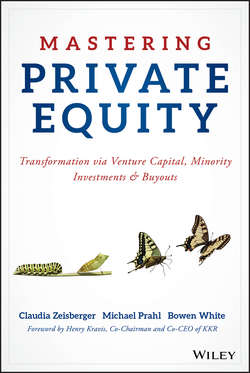Читать книгу Mastering Private Equity - Prahl Michael - Страница 11
На сайте Литреса книга снята с продажи.
SECTION I
PRIVATE EQUITY OVERVIEW
1
PRIVATE EQUITY ESSENTIALS
THE LP PERSPECTIVE
ОглавлениеCOMMITTING CAPITAL AND EARNING RETURNS
Investors have traditionally allocated capital to PE due to its historical outperformance of more traditional asset classes such as public equity and fixed income.17 However, this outperformance comes with higher (or rather different) risks first and foremost due to the illiquid nature of PE investments. Given its lack of liquidity and the long investment horizon of a PE fund, hitting a target allocation to PE is a far more challenging task than maintaining a stable allocation to any of the liquid asset classes.18 In addition, PE funds’ multiyear lock-up and 10-day notice period for capital calls introduce complex liquidity management questions.
Effectively managing portfolio cash flows is among the key challenges faced by investors in the PE asset class. LPs starting a PE investment program from scratch must prepare for years of negative cumulative cash flows before a positive net return will eventually be generated by their PE portfolios. Seasoned investors with a well-diversified exposure to PE, on the other hand, will often have commitments to well over 100 funds and a complex set of cash flows to manage. A PE fund’s “J-curve” provides a way to visualize the expected cash flow characteristics of an LP’s stake in an individual PE fund and the challenges related to managing a PE portfolio.
THE J-CURVE
A PE J-curve represents an LP’s cumulative net cash flow position – the total capital invested along with fees paid to the PE firm minus the capital returned to the LP by the GP – in a single fund over time. Exhibit 1.6 illustrates the characteristic cash flow for an LP (with a US$10 million commitment to a $100 million fund) over the fund’s 10-year life. For simplicity’s sake we assume both consistent drawdowns from the GP and exits split evenly across the years. It should be noted that capital calls and distributions are difficult to forecast with any degree of accuracy, requiring LPs to develop a flexible approach to cash management.19
Exhibit 1.6 PE Fund Cash Flow J-curve
Early in the investment period, the J-curve has a steep negative slope, as a fund’s initial investments and management fees (paid on committed capital) result in large cash outflows for its LPs. As the fund begins to exit its portfolio company holdings, distributions of capital slow the J-curve’s descent; some funds may in fact show a positive slope before the end of the investment period. While the low point of a J-curve is theoretically defined as the fund’s total committed capital, J-curves rarely dip below 80 % of committed capital due to the time required to deploy capital and early divestment activity. In fact, many funds do not even reach a net drawdown of more than 50 %.
Following the start of the divestment period, the J-curve turns upward as exit activity picks up and invested capital plus a share of profits are returned to LPs. Capital called for follow-on investments and management fees continue to generate small LP outflows during the divestment period. As soon as the J-curve crosses the x-axis, the fund has reached breakeven; the final point on the J-curve represents an LP’s total net profit generated by the fund.
While LPs will attempt to optimize their portfolio allocation, modeling cash flows as well as net asset values remains challenging, given the blind pool nature of the funds and the overall scarcity of data in PE. The secondaries market nowadays offers a realistic avenue to add liquidity, shorten the J-curve and manage a PE portfolio proactively.
17
Please refer to Chapter 19 Performance Reporting for a detailed comparison of PE and public market performance.
18
Our Chapter 18 LP Portfolio Management takes a closer look at the challenges of deploying assets under management into PE and VC; Chapter 23 Risk Management complements the discussion.
19
Please refer to Chapter 18 for further insight into the cash management challenges LPs face when starting a PE investment program or when managing multiple funds in a PE portfolio.
